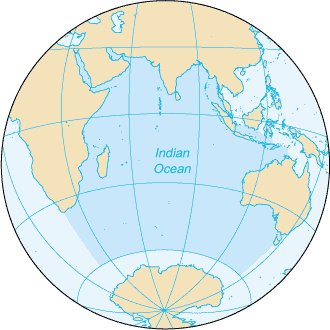What is the importance of Indian Ocean for India? (CSE 1999)
Mention the advantages which India enjoys being at the head of the Indian Ocean. (CSE 1996)
The Indian Ocean is the third largest of the world's oceanic divisions, covering about 20% of the water on the Earth's surface. It is bounded on the north by the Indian subcontinent; on the west by East Africa; on the east by Indochina, the Sunda Islands, and Australia; and on the south by the Southern Ocean (or, depending on definition, by Antarctica). It is the only ocean to be named after a country, i.e., India.
1.The Indian Ocean |
2.Bathymetric map of the Indian Ocean |
India is situated at the North middle of the Indian Ocean. It makes three boundaries of India and delivers it many benefits in economic, climatic and strategic fields.
| ECONOMIC AND COMMERCIAL ADVANTAGES · In the South Sri Lanka is neighboring the tip of the India. In the South-east, countries like Malaysia, Indonesia etc. are situated. India has developed sea-route trade along with these countries since historical period. · The major routes connecting east and west part of the world pass through Indian Ocean and India is a mid-destination for these routes. · After the opening of Suez-canal, the way to Europe has become more convenient through the Indian Ocean increasing to the benefits of India. · Trade routes to America, Africa and Europe pass through the Indian Ocean, this makes Indian position significant. |
CLIMATE ADVANTAGE
· It keeps the climate of the southern India moderate and gives most of the rain India through the south-west monsoon.
· Providing a long sea coast, the Indian Ocean delivers, advantage of fishing, coastal vegetation etc.
| STRATEGIC ADVANTAGE · It covers and protects three boundaries of India, reducing the huge cost of protection. · It prevents confrontation with neighboring countries which exist with land-boundary connected countries like Pakistan, China and Bangladesh. |


